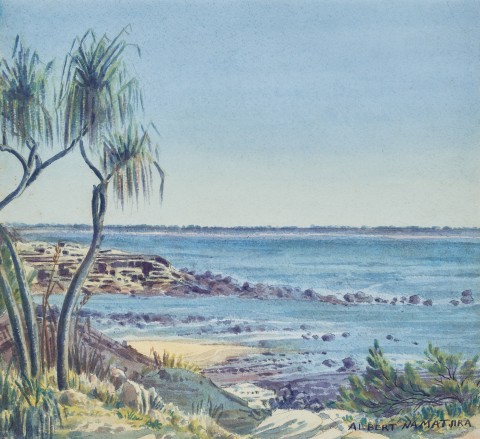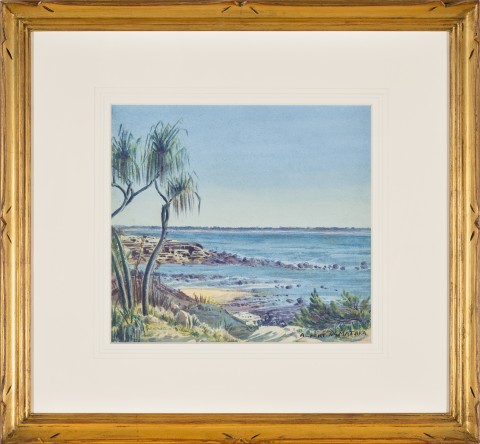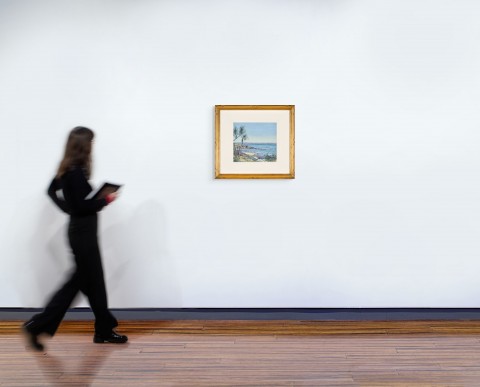ARAFURA SEA AT DARWIN, 1950
ALBERT NAMATJIRA
watercolour on paper
34.0 x 37.0 cm
signed lower right: ALBERT NAMATJIRA
bears inscription verso: Coastline, Darwin / 60 gns / A Hord / 7
Painted in Darwin, July 1950
Anthony Horderns' Fine Art Gallery, Sydney (as ‘Coastline, Darwin, N.T.)
Private collection
Gould Galleries, Melbourne (as ‘Coastline, Darwin, N.T.’)
Private collection, Melbourne, acquired from the above in 1984
The Aranda Group: Seven Aboriginal Water Colour Artists, Anthony Horderns' Fine Art Gallery, Sydney, April 1952, cat. 7 (label attached verso, as ‘Coastline, Darwin, N.T.’)
Albert Namatjira, Rex Battarbee Gallery, Alice Springs, 28 – 29 August 1952 (as ‘Coastline Darwin’)
The Director's Choice 2012, Gould Galleries, Melbourne, 19 July – 31 August 2012, cat. 10 (illus. in exhibition catalogue, as ‘Coastline, Darwin, N.T.’)
Freeden, R., 'Namatjira Paints His First Seascape', The Australian Women's Weekly, Sydney, 16 September 1950, p. 36 (illus.)
McGregor, K., The Life & Times of Albert Namatjira, Badger Editions, Melbourne, 2021, pp. 101 (illus.), 430
Namatjira Womens Weekly.jpg
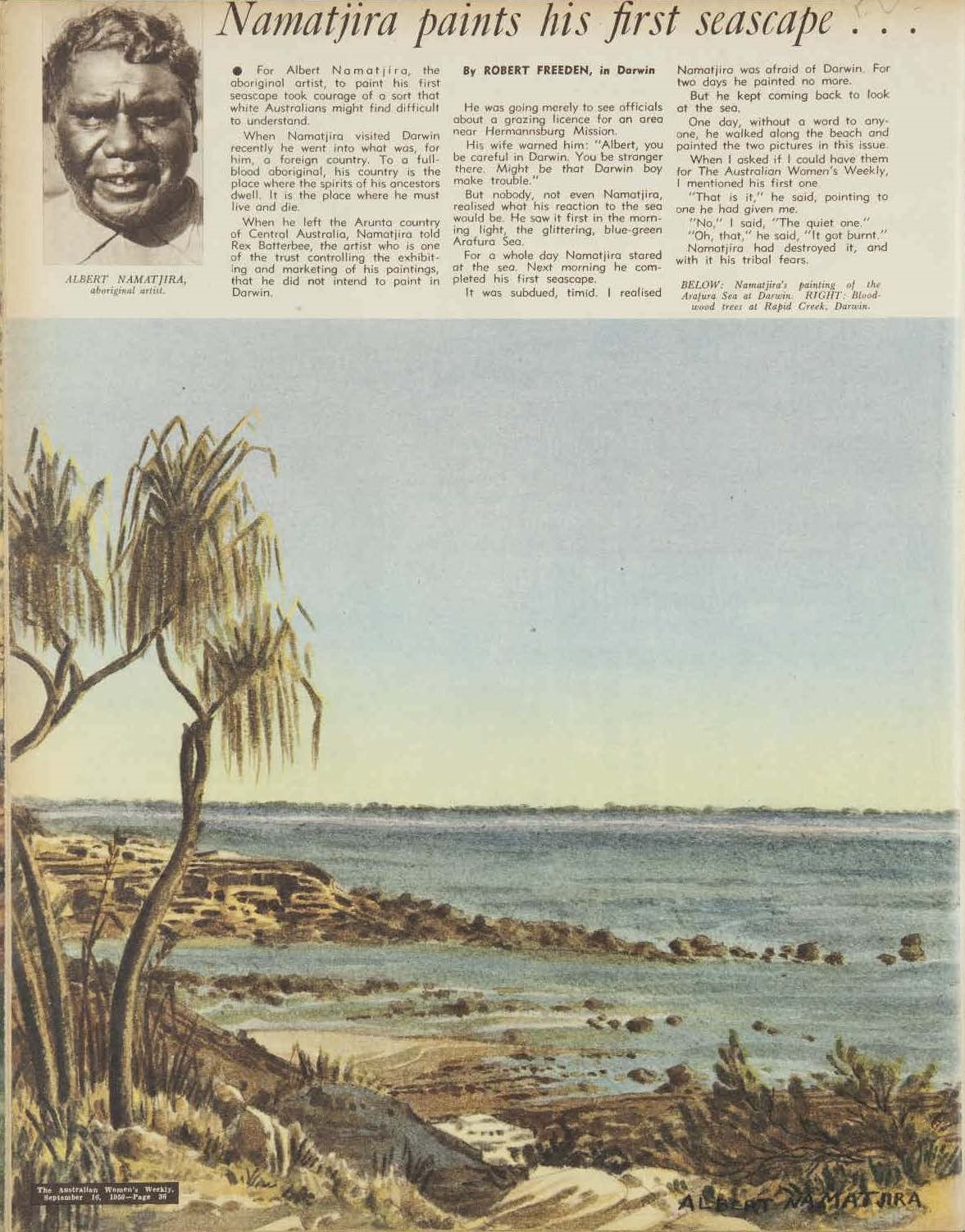
From his earliest watercolours in the 1930s, Albert Namatjira fostered the foundation for the later emergence of Indigenous art at Papunya forty years later and the flourishing expansion of first nations art that would follow. A household name by the 1950s, Namatjira’s evocative landscapes of inland Australia were fundamental to how Australians viewed their island home. ‘Namatjira's dramatic entry into the Australian art world was both inspired and inspiring. He inspired his own and subsequent generations of Aboriginal people and artists across Australia. In skillfully adopting the methods and materials of Western landscape painting he challenged the relegation of Aboriginal art to the realm of archaeology and ethnography. Namatjira became the most prominent Aboriginal Australian of his era and, in 1957, was the first Aboriginal person to be granted full citizenship.’1
Arafura Sea at Darwin, 1950, a rare and important seascape was painted on Namatjira’s first trip beyond central Australia, travelling to Darwin in July 1950 on an ultimately unsuccessful mission to gain approval to acquire a pastoral lease north-west of the Haast’s range where he intended for his family to graze cattle. On 19 July, he arrived in Darwin, a place he thought the biggest in the world at the time; Namatjira was yet to embark on his 1954 journey to the southern capitals Sydney, Canberra (to be presented to the Queen), then Melbourne and Adelaide before returning to Alice Springs. Although not planning to paint on this trip, his intentions changed after a visit to Rapid Creek beach close to where he was staying, and with the Arafura Sea stretching out beyond, he vowed to return and record these watery scenes. Namatjira painted perhaps four or five seascapes whilst in Darwin; the first attempt he destroyed feeling it was an inferior work. Two watercolours were illustrated in the September edition of the Australian Women’s Weekly magazine: Bloodwood trees at Rapid Creek, 1950 and the present Arafura Sea at Darwin, 1950 which was featured in colour. The accompanying article written by Robert Freeden under the title, ‘Namatjira Paints His First Seascape’, noted that ‘…For Albert Namatjira, the aboriginal artist, to paint his first seascape took courage of a sort that white Australians might find it difficult to understand. When Namatjira visited Darwin recently he went into what was for him, a foreign country… But nobody, not even Namatjira, realised what his reaction to the sea would be. He saw it first in the morning light, the glittering blue-green Arafura Sea. For a whole day Namatjira stared at the sea. Next morning, he completed his first seascape. It was subdued, timid. I realised Namatjira was afraid of Darwin. For two days he painted no more. But he kept coming back to look at sea. One day without word to anyone, he walked along the beach and painted the two pictures in this issue.’2
Albert Darwin July 1950, collection of Ken McGregor.jpg
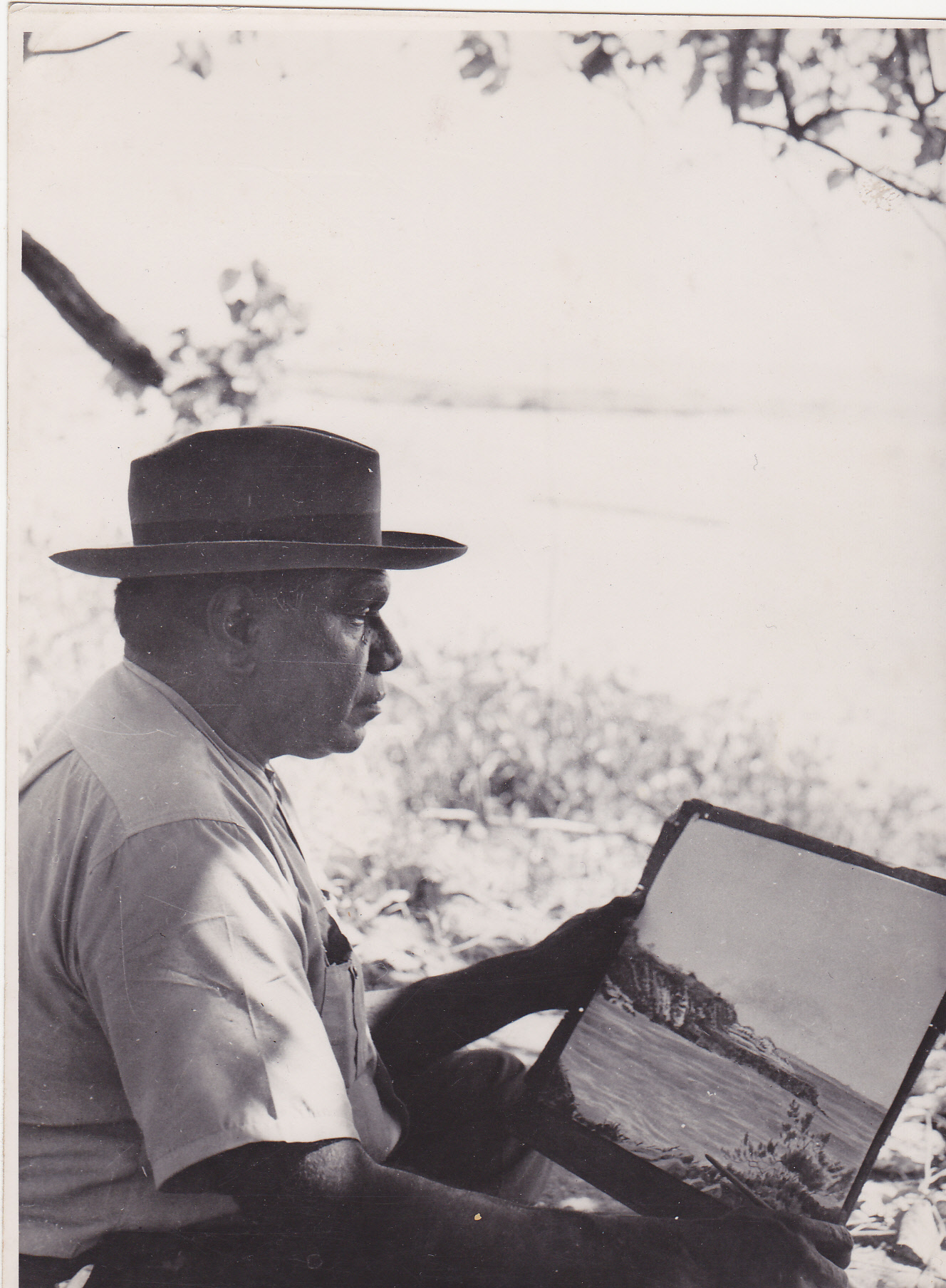
The art of Albert Namatjira is now understood to have inspired his own and subsequent generations of Aboriginal people and artists across Australia. Brenda Croft argues that the artist’s gift to Indigenous and non-Indigenous people is ‘more than the sum parts of watercolour paints on paper. It is an essence that resides in the strength of Namatjira’s work – his courage, his sorrow, his spirituality – where the enduring influence of this one man upon the entire indigenous arts and culture industry continues to be felt.’3
1. Watson, K., ‘Poetic Justice: an overview of Indigenous Art’, in Perkins, H., One Sun, One Moon: Aboriginal Art in Australia, Art Gallery of New South Wales, Sydney, 2007, p. 20
2. Freeden, R. ‘Namatjira Paints His First Seascape’, The Australian Women’s Weekly, Sydney, 16 September 1950, p. 36
3. Croft, B., ‘Albert’s Gift’ in French, A., Seeing the Centre: The Art of Albert Namatjira, 1902 – 1959, National Gallery of Australia, Canberra, 2002, p. 148
CRISPIN GUTTERIDGE
